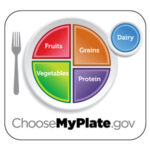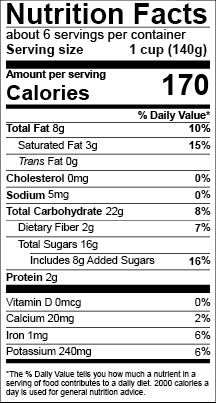Key Facts
- A “serving size” for a food is found on the Nutrition Facts label
- A “portion” of food refers to how much food you eat at a meal or as a snack
- There are ways to help estimate the right portion size for you without having to measure or weigh foods

Understanding the nutritional content of a meal is important. To help determine the nutritional content of your meals, most foods, with the exception of fruits, vegetables, meats, and some prepared foods, have a Nutrition Facts label as a tool to help you figure out what and how much of each nutrient you are eating. The Nutrition Facts label shows the content of nutrients for a specific serving size. While Nutrition Facts labels have useful information, oftentimes people eat differently than what the serving size on the label reflects.
What is a “serving size” versus a “portion”?
A serving size generally refers to the information on the Nutrition Facts label. A serving size is determined using guidelines published by the FDA (the Food and Drug Administration). Serving sizes are intended to help a consumer figure out about how much of a food is “typically” eaten at one time and also to provide a reference point for all of the data provided in the Nutrition Facts label.
In contrast to a serving size, a portion is the true amount of food someone puts on his or her plate. A portion may be more or less than a serving size. Portions are generally how people talk about the amount of food they eat. Someone’s portion can vary depending on their age, stage of development, hormones, gender, activity level, hunger level, and many other factors.
Why does serving size matter?
Serving size matters if you are trying to understand the nutritional makeup of a food using the Nutrition Facts label. These quantities are often based on the “usual” amount of a food that a person would consume; for example the serving size of yogurt is 1 cup whereas the serving size of sour cream is 2 tablespoons. When looking at a Nutrition Facts label, all of the information is based on the serving size. For example, in the sample Nutrition Facts label shown below, the serving size is 1 cup, and there are 6 servings (6 cups) in the entire container. If you ate more than one cup, you would need to multiply all of the lines on the label to reflect the nutritional information in the amount you ate. For example, in 2 cups of this food, (2 servings), there would be 16 grams of fat and 4 grams of protein.

Additionally, understanding how to use the Nutrition Facts label can help you figure out if you are getting enough of the nutrients that your body needs.
Is a serving size the amount I’m supposed to eat?
No! A serving size is simply the amount determined by the FDA as the amount “generally consumed” in order to list the nutrient data for one serving. The FDA doesn’t know if you just had a snack and only want a taste of another food if you are really hungry and need to fuel up if you’re a man or a woman, or your age and height. All of these factors (and many more) contribute to the amount of food your body needs. For example, the serving size for bread is one slice. Sometimes this might be the amount of bread you eat if you were having, for example, a piece of toast with eggs. Other times, you might have a sandwich made with two slices of bread.
Why do portion sizes matter and how do I know how much I need?
Listening to your hunger and fullness cues is a good way to understand how much food your body needs. Your body’s goal is to ensure you take in the right amount of calories daily to fuel all your body functions, so starting to eat when you’re hungry and stopping when you are full, will ensure that you are eating the portion sizes that are right for you. A good place to start recognizing your hunger and fullness cues is to ensure you are eating a balanced diet. Many dietitians use “MyPlate” to teach people about balanced intake of food. In this meal pattern, the plate is divided into three sections. One half of the plate is for fruits and vegetables, one quarter of the plate is for protein and the final quarter of the plate is for carbohydrates, ideally a source of whole grain. Eating regularly in a balanced way helps ensure that our bodies get not only all the energy we need for the day, but also all the important nutrients we need throughout the day. For example, making sure half your plate is fruits and/or vegetables rather than just taking a bite of a fruit or vegetable is important to ensure we get all the vitamins and minerals that come with these food.
Sometimes it can be challenging to eat the right amount that your body needs, such as at restaurants where meals are pre-portioned (served in a specific amount) or at parties where you might “graze” and eat snack foods over a longer period of time. In these cases, having an idea of what a portion of a particular food looks like for you, and understanding how much you need to be satiated, may help you to ensure that you eat the right amount for your body.
How do I know if I’m eating the right portions for me?
It’s always a good idea to talk with your health care provider or a registered dietitian to make sure you are eating the right amounts of a variety of foods based on your hunger and fullness levels to help meet your body’s needs.
Our health guides are developed through a systematic, rigorous process to ensure accuracy, reliability, and trustworthiness. Written and reviewed by experienced healthcare clinicians from Boston Children's Hospital, a Harvard Medical School teaching hospital and consistently ranked as a top hospital by Newsweek and U.S. News & World Report, these guides combine clinical expertise, specialized knowledge, and evidence-based medicine. We also incorporate research and best practices from authoritative sources such as the CDC, NIH, PubMed, top medical journals, and UpToDate.com. Clinical specialists and subject matter experts review and edit each guide, reinforcing our commitment to high-quality, factual, scientifically accurate health information for young people.
